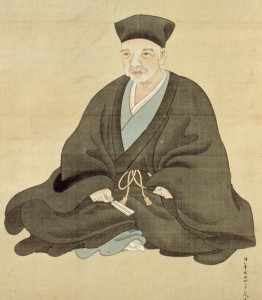A Summary of Tea Master Sen no Rikyu’s architecture and design sense from “The Class Tradition of Japanese Architecture – Morden Versions of the Sukiya Style” Weather hill/ Tankosha : New York, Tokyo & Kyoto. 1972, text by Teiji Itoh, photgraphs by Yukio Futagawa , translated from the Japanese by Richard L.Gage.

Photo source: http://www.sakai-rishonomori.com/rikyu_akiko/sennorikyu/
Tea Master Sen no Rikyu (1521-91) was the student of Takeno Jo-o. (1504 -55) The coloured Shoin (書院) designed by him was the origin of Sukiya architecture. He exercised the taste of refinement and subtlety in a word ‘Wabi’ to exclude all the trappings and ornaments fittings in ordinary homes which permeated into many japanese architecture among residential, place of entertainment such as restaurants, inns and public teahouse in that era.
“ Instead of pursuing form & color, Rikyu tried to follow the path of personal and introspective spiritual development.” (p.20) He adored “ unlimited formal possibilities ties in the commonplace.” (p.20) “ unlimited color possibilities in colorless zones.” (p.20) However, “ He did not value skillful manipulations of form and color.” (p.20) “ He denied the use of color (as befitted the nature of his interpretation of wabi) and suggesting the boundless possibilities of color ” (p.19) by using “Bengara: staining of woodwork by expensive red oxide of iron used to produce the pigment. (This powder origin from Bengal district of India, applied directly to the wood, it produced a rich shade of vermilion, but it was more customary to mix it with powdered black ink to obtain a smoky hue. After the paint was applied, it was treated with rapeseed oil to halt the staining process.)” (p.19)

Photo source: http://nippon-kichi.jp/kichiCnt/img/6143/6143_02_o.jpg
Rikyu’s disciple Furuta Oribe (1544-1615) did not follow his master’s idea entirely. He loved a wide variety of forms by using “strangely shaped tea bowl in tea ceremony.” (p.20) He preferred bright and sunny interior in his tearooms and tea houses, instead of Rikyu’s favorite dark-painted wooden members, he chose lighted painted one similar to
the tone of unfinished wood.
Oribe’s disciple Kobori Enshu (1579-1647) follows Oribe but “developed his own taste of ‘loveliness of elegant simplicity’ including cleverly designed nail covers (kugi-kakushi) in the woodwork and metal pulls in the sliding fusuma panels.” (p.20)